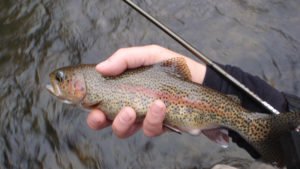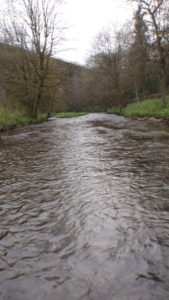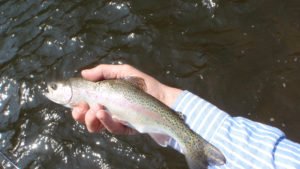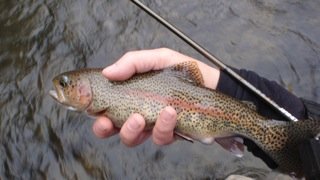Fishing Report -15th May 2016
When at last the better weather arrived, I thought I would attempt my first evening session. And there’s only one spot I head for when time is limited – Signpost’s.
As ever, St Anne’s Church clock was striking 7.00 as I tackled up on the bridge above the Anglers’ Rest. I had chosen my 10 ft Sunray 2 weight with the micro thin line. I’m increasingly impressed with this set up, which I finished off with one of Stuart’s short furled leaders and 3 or 4 feet of Stroft tippet. It is very forgiving when setting the hook, yet there are reserves of power in the butt when needed. There were a few Olives in the air above the bridge so I opted for a Plume Tip, of which I’d been reminded when reading Jeremy Lucas’s blog on the Sunray website. This fly, or the not dissimilar IOBO Humpy, is all you need really when Olives are about. It wasted no time in bringing a fish up, a nice little hand-sized brownie which I quickly steered out of the pool. Several more followed as I explored the run-in,

including a good sized wild rainbow in its spawning colours. The fly does have one drawback however (with apologies to Jeremy) – it’s a bugger to see in broken water! I missed out the fast water on the bend and to give my old eyes a rest,recommenced with a more visible Parachute Adams in the flats opposite the cottage. Now the fun really started and by the time the clock struck 8.00 I’d landed 15 fish (only one a stockie) and had interest from many more. By half past I’d added three more to my tally, then the temperature dropped and it was all over for the evening. I’m sure I could have pressed on and had a couple more, but I was content.

Just reverting to Sunray for a moment,we’ve asked Tom Bell, the brains behind this innovative company, to join us for our Bugs & Burgers Evening on 10th June.He’ll be bringing a selection of his rods and lines for us to try, so I hope you will be able to come along and find out what all the fuss is about.
Thursday was looking good so I contacted Peter B to see if he would like to join me on my first full day visit. He would, and moreover offered to supply the picnic. We opted for Locked Bridge where we found Bill Ryan about to go downstream. Don & Keith had already gone upstream but I knew they would have gone straight up into the Dale, so we fished up from the bridge to
the start of the Dale. I left Peter in Quaker and got into the pool above. We had seen a few Hawthorn flies on the wing so I started off with a Black Klink. I was reasonably confident that fish would be on the look out for these flies, particularly as the day was quite breezy. The fish clearly had other ideas and I had nothing to show for my efforts by the time I’d reached the run-in.
Off came the Klink, replaced with a s16 Black Nymph. First cast into the seam brought a strong take from a brown which flashed off downstream in the fast water.Eventually he was persuaded back up and into the net. Whilst playing him, I thought I’d spotted a movement close to the bank in thin water above a tree stump. I flipped the nymph up into the run, and once again a
brown was in play. Slightly smaller this time but a lovely wild fish. A cast into the fast water drowned the indicator but fortunately I could still see it underwater as it stabbed forward. I lifted into a very strong rainbow which took a while to reach the net. Another spring spawner like the one I’d had the previous visit. Great to see these fish thriving. As I moved up into the
rocky pocket water I changed to a Parachute Adams. I’d seen quite a few Olive Uprights on the wing and felt it was time to get back to the dry. I was dropping the fly into every little hole, keeping the line off the water, wishing I’d brought the 10 footer or the Tenkara. Soon a succession of little brownies had fallen for the dabbled fly, some coming to hand, others briefly on and off in the tumbling water.
By now, Peter had leap-frogged me and was fishing the long pool below the gate. His leader had tangled in the bank side cover, so he changed his tippet and accepted my offer of one of my little Black Nymphs. His first cast was placed alongside a piece of LWD and when the indicator disappeared we both thought the nymph had snagged on it. His reaction brought a firm resistance,
then the rod bucked as another wild brown was in play.
After a long lunch we went down to the Marble Works and fished up Beat 8. At last, the fish were looking out for Hawthorns and in some fast shallows I tempted three lovely little rainbows in

succession to the Black Klink. As I rounded a bend I spotted another rod ahead of me, so I backed off and left him to it.
Over the next couple of weeks we should see a bit more of the Hawthorns, followed by the start of the Black Gnat. The Olive Uprights will continue to be our mainstay as far as upwing activity is concerned, with Medium Olives, Pale Wateries and Iron Blues also on the menu. I would also expect to see the start of the caddis activity, with Agepetus being the highlight, particularly on the
upper beats. It’s still early for the Mayfly, although a few solitary duns are now being seen each day. The main emergence is expected over the first and second weeks of June. Bear in mind that the upper beats have had some of the best hatches in recent years.
Keith Burtonwood recently suggested to me that the Baetis Cripple, suitably beefed up, might make a good Mayfly emerger pattern. This is his suggested dressing:

Hook: Tiemco SPBL size 12
Tails: Black Cock shrouded with grey Zelon to suggest the shuck.
Butt: Dark brown Superfine dubbing.
Body: Cream Variant Superfine dubbing.
Stub Wing: Grey Zelon.
Hackle: Grizzle, three turns behind and two in front of the wing, clipped short on the underside.
I’m always reluctant to add to the hundreds of Mayfly patterns already out there but this style of dressing, popularized by Craig Mathews at Blue Ribbon Flies in Montana, is incredibly robust and just the thing needed when you are getting plenty of action. I can’t resist tinkering with patterns and I can already envision a variant with an olive wing and an olive dyed grizzle hackle. (Sorry Keith!)
Finally, if you find yourself on the river on a muggy, overcast day in August, with the fish going wild, this is what might be

causing the fuss. A wood ants nest, teeming with activity, by the path at the top of Beat 7. They all sprout wings at the same time and take to the air, some inevitably falling on the river. Trout love
‘em so it pays to have a few ant imitations in your fly box!
Tight lines!
David.
PS: Keith recently found a Tree Creeper tangled in some line hanging from a branch in Lenzini’s. Fortunately he was able to reach the line and free the bird, which seemed none the worse for its experience. The fact that the line and its attached nymph were easy to reach makes it even more unforgivable that the angler responsible couldn’t be bothered to retrieve it at the time. I’d like to draw your attention to Fishing Rule 14 which specifically refers to this. There is a little gadget called a Flytriever , available from Peter Arfield in Bakewell, which everyone should carry for this eventuality.

